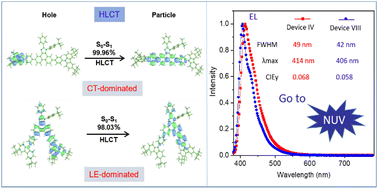Donor–acceptor–donor molecules for high performance near ultraviolet organic light-emitting diodes via hybridized local and charge-transfer processes†
Abstract
Due to the difficulty in finding suitable emitters with a wide energy bandgap and strong photoluminescence as well as high exciton utility efficiency, developing high-performance near ultraviolet organic light-emitting diodes (NUV OLEDs) is a difficult task. In this study, using carbazole as a donor and phenanthroimidazole as an acceptor, two bipolar donor–acceptor–donor compounds (5,10-CzPPI and 6,9-CzPPI) were developed. With extremely high decomposition temperatures and glass transition temperatures, both dyes have outstanding thermal and morphological stabilities. The molecules possess the hybridized local and charge-transfer (HLCT) characteristics and exhibit high-level reverse intersystem crossing (hRISC) of excitons from the triplet excited state to the singlet excited state. Nondoped and doped devices using the molecules as emitters were fabricated and NUV emissions were obtained with high efficiencies. The device using 6,9-CzPPI as a dopant exhibits the best excellent EL performances, radiates in the NUV region with a maximum emission at 406 nm, and exhibits a maximum external quantum efficiency of 5.17%. The device shows excellent color purity with a remarkably small full width at half maximum (FWHM) of 42 nm and Commission Internationale de L’Eclairage coordinates (CIEx,y) of (0.157, 0.058). Our research manifests that the symmetrical strategy of conjugating a rigid carbazolyl group with phenanthroimidazole at suitable sites can establish high efficiency HLCT molecules with excellent color purity by finely tuning the electronic structures.

- This article is part of the themed collection: Journal of Materials Chemistry C HOT Papers


 Please wait while we load your content...
Please wait while we load your content...